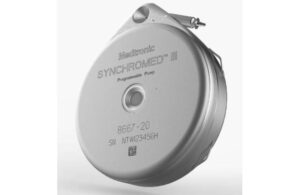
The medtech giant designed SynchroMed III to treat patients with chronic pain, cancer pain and severe spasticity. The targeted drug delivery (TDD) system alleviates symptoms by delivering medication directly to the fluid surrounding the spinal cord.
SynchroMed III builds upon the previous SynchroMed II system, featuring a new “refill only” physician workflow. This enables more efficient programming, while improved electronics feature firmware capable of updates post-implant. Additionally, the system has other protections for patient data through enhanced cybersecurity.
Medtronic said its system also carries forward several mid-generation durable design enhancements from the previous generation.
The system delivers fluid via a catheter connected to a small, battery-powered programmable pump. Patients with the pump can continue accessing diagnostic imaging through Medtronic’s 1.5T and 3T full-body MRI conditionality.
SynchroMed III can work with the company’s Control Workflow, which helps to eliminate the use of systemic opioids by certain patients. The framework can be tailored to individual patients and it assists physicians in identifying patients likely to have positive outcomes.
Control Workflow supports oral opioid tapering and drug holidays, allowing for treatment with the lowest effective doses. This can improve pain relief compared to a combination of oral and intrathecal treatment.
Medtronic plans to make SynchroMed III commercially available later this calendar year.
“Medtronic has offered targeted drug delivery therapy for over 30 years, and we continue to further enhance this technology,” said David Carr, VP and GM, Pain Interventions within the Neuromodulation business at Medtronic. “The SynchroMed III system brings forward several important developments and represents another step forward in our commitment to delivering solutions that alleviate pain and improve lives through innovative medical technology.”

